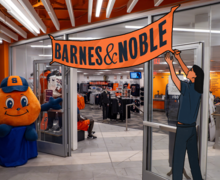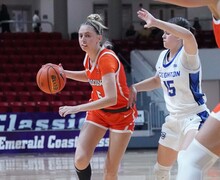Race : D-III Rochester uses helmet sensors in brain-activity study
For six minutes, Scott Greene’s world went dark. When he woke up, the Michigan State running back was on the Spartan sidelines, out of a game against Indiana with a throbbing headache and a spotty memory.
‘I remember I took the handoff — it was an isolation play up the middle,’ said Greene, who played at MSU from 1992-95. ‘The safety flew down in the box and leveled me. The next thing I knew, I was out, and I couldn’t understand why.’
Greene couldn’t understand his head injury as a player. But as a head coach at Division-III University of Rochester, he’s making sure his team understands head injuries now. As part of an NFL-funded, season-long study, 10 Rochester players wear helmets fitted with six sensors that record the force of every hit they take to the head. The object of the study is to measure how all types of head-bashing tackles — along with their energy, force and direction — can deteriorate a player’s brain activity.
Concussion-dealing blows like the one Greene took are taken into account, but smaller hits are the focus for Jeff Bazarian, an associate professor of Emergency Medicine, Neurology, Neurosurgery, and Community and Preventive Medicine at the University of Rochester.
Bazarian, who leads the study, conducted a similar study with high school players wearing helmets with sensors in 2008 and found that smaller, ‘non-concussive’ hits had the potential to cause as much long-term brain damage as the hits that knock players out.
The fact that these hits often go unmonitored at the high school, collegiate and professional levels makes them all the more troublesome to Bazarian, especially in light of former NFL players dealing with dementia.
‘You see a player take a hit and pop back up and assume they’re fine,’ said Bazarian, who has been at Rochester since 1994. ‘What we’re finding is that’s not the case at all. Players that aren’t dazed, confused or knocked out still put their brain health on the line.’
This study has more depth than Bazarian’s high school one, but more importantly, it has the financial backing of professional football. The NFL donated a $99,000 grant to back Bazarian’s project and the costly brain scans and helmet technology that came with it.
Bazarian and head athletic trainer Eric Rozen picked their 10 test subjects carefully. In August, two offensive linemen, three defensive linemen, two linebackers, a tight end, fullback and running back were selected to participate in the season-long study.
Rozen said the study emphasized linemen for a reason. In the trenches, players absorb the most mild or secondary blows.
‘For the most part, we’re not talking about skill position players,’ Rozen said. ‘We wanted to look at the guys whose heads were getting thrown around fifty times a game.’
The 10 at-risk players were given diffusion tensor imaging scans — what Bazarian calls ‘MRI scans on steroids’ — at the beginning of the season. The scans color code what sections of the brain have been adversely affected by head trauma.
At various points in the season, study coordinator Kirsten Ross and medical student Bobby Klein collect additional data right from the players’ helmets. The ordinary-looking Riddell Speed model helmets are fitted with data chips capable of storing information up to about 200 individual collisions.
Rozen said the study gets more comprehensive with each new data collection.
‘We want to have as many plot points as possible,’ Rozen said. ‘If these players are in fact getting worse, we need to know where before we know why.’
Bazarian and Rozen will administer another DTI scan at the end of the season Nov. 12 after a home game against Hobart, and they will compare data right after.
Brian Rieger, director of the Concussion Management Program at Upstate Medical University Hospital, said he expects the data to show that the mild or moderate hits aren’t so mild or moderate.
‘Any time a player sustains repetitive head trauma over the course of months, that player will be worse for wear,’ Rieger said. ‘Even if the player isn’t experiencing highlight-reel hits, there’s still the opportunity for damage.’
But there’s also the opportunity to heal. Bazarian never measured the amount of brain function that returned to players in his 2008 study, but he plans to analyze the 10 subjects of his 2011 study six months after the season.
Bazarian has a hypothesis about the amount of healing that will take place in the six months of non-football activity.
‘They’ll heal, but some long-term effects are expected,’ Bazarian said. ‘We can’t wait for the results.’
Neither can Greene’s players. The Rochester players are eager to find out just how dangerous the game is for their bodies.
Greene realized just how interested his players were at the prospect of joining the study in the summer, when he asked for 10 volunteers and got many more.
Rochester Athletic Director George VanderZwaag said the opportunity to participate in an NFL-sponsored study was enticing for the university’s academic interests, too.
‘As a research institution, you’re happy to carry the banner for any project like this,’ VanderZwaag said. ‘We’re happy the NFL gave our university that grant.’
Greene is happy, too. The end result of the program has the potential to make the game he coaches safer for all players at every level of competition.
‘Player safety has become a priority,’ Greene said. ‘We hope that we find out what the best way to keep our players safe and healthy is through this study.’
Published on October 31, 2011 at 12:00 pm
Contact Nick: nctoney@syr.edu | @nicktoneytweets





